[English] 日本語
 Yorodumi
Yorodumi- PDB-6tsv: Tail of empty GTA particle computed with helical refinement, C6 s... -
+ Open data
Open data
- Basic information
Basic information
| Entry | Database: PDB / ID: 6tsv | ||||||||||||||||||||||||
|---|---|---|---|---|---|---|---|---|---|---|---|---|---|---|---|---|---|---|---|---|---|---|---|---|---|
| Title | Tail of empty GTA particle computed with helical refinement, C6 symmetry | ||||||||||||||||||||||||
 Components Components | Tail tube protein Rcc01691 | ||||||||||||||||||||||||
 Keywords Keywords | VIRUS / "helical refinement" / "gene transfer agent" / "bacteriophage" / "tail" | ||||||||||||||||||||||||
| Function / homology | Gene transfer agent, major tail protein / Phage major tail protein TP901-1 / Phage tail tube protein / Phage major tail protein, TP901-1 family Function and homology information Function and homology information | ||||||||||||||||||||||||
| Biological species |  Rhodobacter capsulatus DE442 (bacteria) Rhodobacter capsulatus DE442 (bacteria) | ||||||||||||||||||||||||
| Method | ELECTRON MICROSCOPY / helical reconstruction / cryo EM / Resolution: 3.78 Å | ||||||||||||||||||||||||
 Authors Authors | Bardy, P. / Fuzik, T. / Hrebik, D. / Pantucek, R. / Beatty, J.T. / Plevka, P. | ||||||||||||||||||||||||
| Funding support |  Czech Republic, 7items Czech Republic, 7items
| ||||||||||||||||||||||||
 Citation Citation |  Journal: Nat Commun / Year: 2020 Journal: Nat Commun / Year: 2020Title: Structure and mechanism of DNA delivery of a gene transfer agent. Authors: Pavol Bárdy / Tibor Füzik / Dominik Hrebík / Roman Pantůček / J Thomas Beatty / Pavel Plevka /   Abstract: Alphaproteobacteria, which are the most abundant microorganisms of temperate oceans, produce phage-like particles called gene transfer agents (GTAs) that mediate lateral gene exchange. However, the ...Alphaproteobacteria, which are the most abundant microorganisms of temperate oceans, produce phage-like particles called gene transfer agents (GTAs) that mediate lateral gene exchange. However, the mechanism by which GTAs deliver DNA into cells is unknown. Here we present the structure of the GTA of Rhodobacter capsulatus (RcGTA) and describe the conformational changes required for its DNA ejection. The structure of RcGTA resembles that of a tailed phage, but it has an oblate head shortened in the direction of the tail axis, which limits its packaging capacity to less than 4,500 base pairs of linear double-stranded DNA. The tail channel of RcGTA contains a trimer of proteins that possess features of both tape measure proteins of long-tailed phages from the family Siphoviridae and tail needle proteins of short-tailed phages from the family Podoviridae. The opening of a constriction within the RcGTA baseplate enables the ejection of DNA into bacterial periplasm. | ||||||||||||||||||||||||
| History |
|
- Structure visualization
Structure visualization
| Movie |
 Movie viewer Movie viewer |
|---|---|
| Structure viewer | Molecule:  Molmil Molmil Jmol/JSmol Jmol/JSmol |
- Downloads & links
Downloads & links
- Download
Download
| PDBx/mmCIF format |  6tsv.cif.gz 6tsv.cif.gz | 97.1 KB | Display |  PDBx/mmCIF format PDBx/mmCIF format |
|---|---|---|---|---|
| PDB format |  pdb6tsv.ent.gz pdb6tsv.ent.gz | 74.5 KB | Display |  PDB format PDB format |
| PDBx/mmJSON format |  6tsv.json.gz 6tsv.json.gz | Tree view |  PDBx/mmJSON format PDBx/mmJSON format | |
| Others |  Other downloads Other downloads |
-Validation report
| Summary document |  6tsv_validation.pdf.gz 6tsv_validation.pdf.gz | 744.3 KB | Display |  wwPDB validaton report wwPDB validaton report |
|---|---|---|---|---|
| Full document |  6tsv_full_validation.pdf.gz 6tsv_full_validation.pdf.gz | 748.7 KB | Display | |
| Data in XML |  6tsv_validation.xml.gz 6tsv_validation.xml.gz | 26.2 KB | Display | |
| Data in CIF |  6tsv_validation.cif.gz 6tsv_validation.cif.gz | 35.3 KB | Display | |
| Arichive directory |  https://data.pdbj.org/pub/pdb/validation_reports/ts/6tsv https://data.pdbj.org/pub/pdb/validation_reports/ts/6tsv ftp://data.pdbj.org/pub/pdb/validation_reports/ts/6tsv ftp://data.pdbj.org/pub/pdb/validation_reports/ts/6tsv | HTTPS FTP |
-Related structure data
| Related structure data |  10566MC  6tb9C  6tbaC  6te8C  6te9C  6teaC  6tebC  6tehC  6to8C  6toaC  6tsuC  6tswC  6tuiC C: citing same article ( M: map data used to model this data |
|---|---|
| Similar structure data |
- Links
Links
- Assembly
Assembly
| Deposited unit | 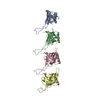
|
|---|---|
| 1 | x 6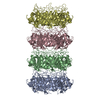
|
- Components
Components
| #1: Protein | Mass: 14420.007 Da / Num. of mol.: 4 / Source method: isolated from a natural source / Source: (natural)  Rhodobacter capsulatus DE442 (bacteria) / References: UniProt: D5ATZ7 Rhodobacter capsulatus DE442 (bacteria) / References: UniProt: D5ATZ7 |
|---|
-Experimental details
-Experiment
| Experiment | Method: ELECTRON MICROSCOPY |
|---|---|
| EM experiment | Aggregation state: PARTICLE / 3D reconstruction method: helical reconstruction |
- Sample preparation
Sample preparation
| Component | Name: Rhodobacter capsulatus DE442 gene transfer agent tail tube Type: COMPLEX Details: tubular structure interconnecting head to baseplate (host recognition device), partial Entity ID: all / Source: NATURAL | ||||||||||||||||||||||||||||||
|---|---|---|---|---|---|---|---|---|---|---|---|---|---|---|---|---|---|---|---|---|---|---|---|---|---|---|---|---|---|---|---|
| Molecular weight |
| ||||||||||||||||||||||||||||||
| Source (natural) | Organism:  Rhodobacter capsulatus DE442 (bacteria) Rhodobacter capsulatus DE442 (bacteria) | ||||||||||||||||||||||||||||||
| Details of virus | Empty: YES / Enveloped: NO / Isolate: STRAIN / Type: VIRION | ||||||||||||||||||||||||||||||
| Natural host | Organism: Rhodobacter capsulatus | ||||||||||||||||||||||||||||||
| Virus shell | Name: HK97-like oblate capsid / Diameter: 380 nm / Triangulation number (T number): 3 | ||||||||||||||||||||||||||||||
| Buffer solution | pH: 7.8 / Details: G-buffer, doi: 10.1016/0003-9861(77)90508-2 | ||||||||||||||||||||||||||||||
| Buffer component |
| ||||||||||||||||||||||||||||||
| Specimen | Conc.: 20 mg/ml / Embedding applied: NO / Shadowing applied: NO / Staining applied: NO / Vitrification applied: YES | ||||||||||||||||||||||||||||||
| Specimen support | Grid material: COPPER / Grid mesh size: 300 divisions/in. / Grid type: Quantifoil R2/1 | ||||||||||||||||||||||||||||||
| Vitrification | Instrument: FEI VITROBOT MARK IV / Cryogen name: ETHANE / Humidity: 100 % / Chamber temperature: 293.15 K |
- Electron microscopy imaging
Electron microscopy imaging
| Experimental equipment |  Model: Titan Krios / Image courtesy: FEI Company |
|---|---|
| Microscopy | Model: FEI TITAN KRIOS |
| Electron gun | Electron source:  FIELD EMISSION GUN / Accelerating voltage: 300 kV / Illumination mode: FLOOD BEAM FIELD EMISSION GUN / Accelerating voltage: 300 kV / Illumination mode: FLOOD BEAM |
| Electron lens | Mode: BRIGHT FIELD / Nominal magnification: 75000 X / Nominal defocus max: -3000 nm / Nominal defocus min: -1000 nm / Cs: 2.7 mm / C2 aperture diameter: 50 µm / Alignment procedure: ZEMLIN TABLEAU |
| Specimen holder | Cryogen: NITROGEN / Specimen holder model: FEI TITAN KRIOS AUTOGRID HOLDER |
| Image recording | Average exposure time: 1 sec. / Electron dose: 42.75 e/Å2 / Detector mode: INTEGRATING / Film or detector model: FEI FALCON III (4k x 4k) / Num. of grids imaged: 1 / Num. of real images: 3114 |
| Image scans | Width: 4096 / Height: 4096 |
- Processing
Processing
| Software | Name: PHENIX / Version: 1.13_2998: / Classification: refinement | ||||||||||||||||||||||||||||||||||||||||
|---|---|---|---|---|---|---|---|---|---|---|---|---|---|---|---|---|---|---|---|---|---|---|---|---|---|---|---|---|---|---|---|---|---|---|---|---|---|---|---|---|---|
| EM software |
| ||||||||||||||||||||||||||||||||||||||||
| CTF correction | Type: PHASE FLIPPING AND AMPLITUDE CORRECTION | ||||||||||||||||||||||||||||||||||||||||
| Helical symmerty | Angular rotation/subunit: 24.4 ° / Axial rise/subunit: 38.4 Å / Axial symmetry: C6 | ||||||||||||||||||||||||||||||||||||||||
| Particle selection | Num. of particles selected: 49821 | ||||||||||||||||||||||||||||||||||||||||
| 3D reconstruction | Resolution: 3.78 Å / Resolution method: FSC 0.143 CUT-OFF / Num. of particles: 49821 / Algorithm: BACK PROJECTION / Symmetry type: HELICAL | ||||||||||||||||||||||||||||||||||||||||
| Atomic model building | Protocol: AB INITIO MODEL / Space: REAL | ||||||||||||||||||||||||||||||||||||||||
| Refine LS restraints |
|
 Movie
Movie Controller
Controller



















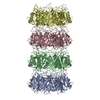
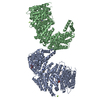
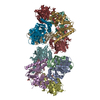
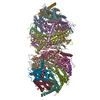
 PDBj
PDBj